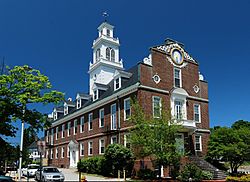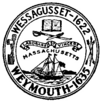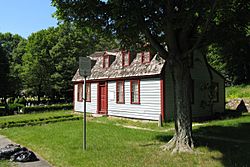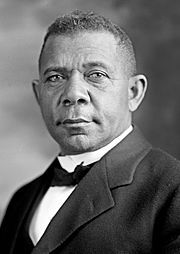Weymouth, Massachusetts facts for kids
Quick facts for kids
Town of Weymouth
|
|||
|---|---|---|---|
|
City
|
|||

Town Hall, built in 1928 as a replica of the
Old State House in Boston |
|||
|
|||
| Motto(s):
Latin: Laborare Est Vincere
("To Work Is to Conquer") |
|||

Location in Norfolk County in Massachusetts
|
|||
| Country | |||
| State | |||
| County | |||
| Settled | 1622 | ||
| Incorporated | September 2, 1635 | ||
| Government | |||
| • Type | Mayor-council | ||
| Area | |||
| • Total | 21.57 sq mi (55.88 km2) | ||
| • Land | 16.77 sq mi (43.42 km2) | ||
| • Water | 4.81 sq mi (12.45 km2) | ||
| Elevation | 200 ft (27 m) | ||
| Population
(2020)
|
|||
| • Total | 57,437 | ||
| • Density | 3,424.99/sq mi (1,322.82/km2) | ||
| Time zone | UTC−5 (Eastern) | ||
| • Summer (DST) | UTC−4 (Eastern) | ||
| ZIP Codes |
02188–02191
|
||
| Area code(s) | 339/781 | ||
| FIPS code | 25-78865 | ||
| GNIS feature ID | 0619462 | ||
Weymouth is a city in Norfolk County, Massachusetts, and one of 13 municipalities in the state to have city forms of government while retaining "town of" in their official names. It is named after Weymouth, Dorset, a coastal town in England, and is the second-oldest settlement in Massachusetts, second only to Plymouth. It is one of the South Shore's more affordable towns and offers a short commute into Boston, MBTA bus and rail service, and a town beach.
As of the 2020 census, Weymouth had a total population of 57,437.
Contents
Demographics
| Historical population | ||
|---|---|---|
| Year | Pop. | ±% |
| 1840 | 3,738 | — |
| 1850 | 5,369 | +43.6% |
| 1860 | 7,742 | +44.2% |
| 1870 | 9,010 | +16.4% |
| 1880 | 10,570 | +17.3% |
| 1890 | 10,866 | +2.8% |
| 1900 | 11,324 | +4.2% |
| 1910 | 12,895 | +13.9% |
| 1920 | 15,057 | +16.8% |
| 1930 | 20,882 | +38.7% |
| 1940 | 23,868 | +14.3% |
| 1950 | 32,690 | +37.0% |
| 1960 | 48,177 | +47.4% |
| 1970 | 54,610 | +13.4% |
| 1980 | 55,601 | +1.8% |
| 1990 | 54,063 | −2.8% |
| 2000 | 53,988 | −0.1% |
| 2010 | 53,743 | −0.5% |
| 2020 | 57,437 | +6.9% |
| * = population estimate. Source: United States Census records and Population Estimates Program data. Source: |
||
As of the 2010 census, there were 53,743 people, 22,435 households, and 13,595 families residing in the city. The population density was 3,174.2 people per square mile (1,225.4/km2). There were 22,573 housing units at an average density of 1,327.1 per square mile (512.4/km2). 64% housing units were owner-occupied and 35% of housing units were renter-occupied. The racial makeup of the city was 82.7% White, 5.2% Black or African American, 0.2% Native American, 5.7% Asian, 0.0% Pacific Islander, 0.6% from other races, and 2.2% from two or more races. Hispanic or Latino of any race were 3.1% of the population.
There were 22,028 households, out of which 27.3% had children under the age of 18 living with them, 48.6% were married couples living together, 10.3% had a female householder with no husband present, and 26.8% were non-families, 37% of which were non-family households with residents over 65 years of age. 30.6% of all households were made up of individuals, and 11.1% had someone living alone who was 65 years of age or older. The average household size was 2.42 and the average family size was 3.08.
In the city, the population was spread out, with 22.0% under the age of 18, 6.6% from 18 to 24, 32.7% from 25 to 44, 23.4% from 45 to 64, and 15.4% who were 65 years of age or older. The median age was 38 years. For every 100 females, there were 90.4 males. For every 100 females age 18 and over, there were 86.3 males.
The median income for a household in the city was $68,665, and the median income for a family was $52,083. Males had a median income of $42,497 versus $35,963 for females. The per capita income for was $24,976. About 9.1% of families and 9.8% of the population were below the poverty line, including 8.3% of those under age 18 and 9.4% of those age 65 or over.
Weymouth has the 10th highest Irish population in the United States, at 33%. As "white flight" occurred in inner-city Boston exacerbated by the start of the cross-district busing program, in the 1960s and 70s thousands of white (predominantly of Irish descent) Bostonians moved to middle/working class suburbs such as Weymouth and Quincy. The blue collar city culture (example: The Boston accent) of places like South Boston and Dorchester is prevalent in the neighborhoods of Weymouth. Weymouth has colloquially been referred to as "Suburban Southie" and "Southie on the South Shore" due to the high influx of South Boston residents and Irish Catholic culture in the town. This trend continues in a different way again today as some longtime South Boston residents are now being priced out due to gentrification. Many are moving out to the more affordable towns on the South Shore.
Demographic breakdown by ZIP code
Income
Data is from the 2009–2013 American Community Survey 5-Year Estimates.
| Rank | ZIP Code (ZCTA) | Per capita income |
Median household income |
Median family income |
Population | Number of households |
|---|---|---|---|---|---|---|
| Norfolk County | $44,692 | $84,916 | $108,943 | 677,296 | 257,451 | |
| 1 | 02190 (South Weymouth) | $36,124 | $77,329 | $98,442 | 16,733 | 6,719 |
| 2 | 02188 (Weymouth Landing) | $35,954 | $68,366 | $80,799 | 14,655 | 6,220 |
| Massachusetts | $35,763 | $66,866 | $84,900 | 6,605,058 | 2,530,147 | |
| Weymouth | $32,832 | $68,113 | $81,987 | 54,366 | 22,526 | |
| 3 | 02191 (North Weymouth) | $31,652 | $64,365 | $86,588 | 8,369 | 3,558 |
| 4 | 02189 (East Weymouth) | $29,185 | $60,059 | $78,079 | 14,609 | 6,029 |
| United States | $28,155 | $53,046 | $64,719 | 311,536,594 | 115,610,216 |
Geography
Weymouth is located at 42°12′23″N 70°56′45″W / 42.20639°N 70.94583°W (42.206458, -70.945919).
According to the United States Census Bureau, the city has a total area of 21.6 square miles (56.0 km²), of which, 17.0 square miles (44.1 km²) of it is land and 4.6 square miles (11.9 km²) of it (21.29%) is water.
Weymouth contains the Weymouth Back River and the Weymouth Fore River; its surroundings, formerly industrial, are now set aside as parks and natural areas including Webb Memorial State Park. There are also a lot of streets named after people and trees.
Weymouth residents often designate which of four distinct 'districts' they live in.
- North Weymouth is considered anything north of the intersection of Church Street, North Street and Green Street. Some of the sites around North Weymouth are Great Esker Park, George Lane Beach, Webb State Park, the Wessagusset Yacht Club, Boston skyline views, and the Abigail Adams Historical Society. It also includes up and coming waterfront property that rivals similar in pricier towns.
- South Weymouth is mostly south of Route 3.
- East Weymouth is somewhat in the center of Weymouth, including Whitman's Pond, Jackson Square, and Town Hall. East Weymouth has several fine examples of Victorian homes, including Queen Anne, shingle, and colonial revival homes. Some particularly fine examples of these homes are being restored on Hillcrest Road.
- Weymouth Landing spans a mile around Weston Park.
Weymouth is bordered on the north by Hingham Bay. Weymouth's territory includes Grape Island, Slate Island, and Sheep Island, all part of the Boston Harbor Islands National Recreation Area. Weymouth is bordered on the west by Quincy, Braintree, and Holbrook. It is bordered on the south by Abington and Rockland. Weymouth is bordered on the east by Hingham.
Climate
The climate in this area is characterized by hot, humid summers and generally mild to cool winters. According to the Köppen Climate Classification system, Weymouth has a humid subtropical climate, abbreviated "Cfa" on climate maps.
| Climate data for Weymouth, Massachusetts | |||||||||||||
|---|---|---|---|---|---|---|---|---|---|---|---|---|---|
| Month | Jan | Feb | Mar | Apr | May | Jun | Jul | Aug | Sep | Oct | Nov | Dec | Year |
| Average high °F (°C) | 36 (2) |
37 (3) |
46 (8) |
57 (14) |
68 (20) |
77 (25) |
82 (28) |
81 (27) |
73 (23) |
63 (17) |
52 (11) |
40 (4) |
60 (16) |
| Average low °F (°C) | 19 (−7) |
20 (−7) |
29 (−2) |
38 (3) |
47 (8) |
56 (13) |
63 (17) |
61 (16) |
53 (12) |
43 (6) |
35 (2) |
24 (−4) |
41 (5) |
| Average precipitation inches (cm) | 4 (10) |
4 (10) |
4 (10) |
3.9 (9.9) |
3.2 (8.1) |
2.8 (7.1) |
2.8 (7.1) |
3.8 (9.7) |
3.3 (8.4) |
3.8 (9.7) |
4.5 (11) |
4.2 (11) |
44.3 (113) |
| Source: Weatherbase | |||||||||||||
Transportation
Weymouth is served by several MBTA bus routes as well as three MBTA Commuter Rail stations: two on the Greenbush Line, at Weymouth Landing and near Jackson Square, and one on the Old Colony Line at South Weymouth. Numbered routes that pass through Weymouth include Massachusetts Routes 3, 3A, 18, 53, 58 and 139.
History
A failed colony
The site of Weymouth first saw European inhabitants in 1622 as Wessagusset Colony, a colony founded by Thomas Weston, who had been the main backer of the Plymouth settlement. The settlement was a failure. The sixty men taken from London were ill-prepared for the hardships required for survival. They also may have lacked the motivation of the Pilgrims as this colony was purely economic in motivation and the men had not brought their families.
By winter, poor planning and bad management led to supplies running out. With the Plymouth colonists having few supplies to share, the Weymouth men began to steal from the local Massachusetts nation. Foraging in cooperation with the Pilgrims and trading with Natives was insufficient, and some colonists began to steal from the natives. By now, many in the colony were ill and all forms of law and order had broken down. The lowest point came when a healthy settler was caught stealing supplies from the Massachusetts and the Massachusetts leaders demanded the thief's execution; the Weymouth men complied but either executed or failed to substitute for execution a dying, sick settler instead.
By April 1623, word of conflict between Native Americans and the Virginia colonists had reached the north and this increased the tension between the two groups. Massachusetts and other native groups began plotting to attack and destroy what was left of the floundering Wessagusset colony and possibly the more successful Plymouth Colony. Massasoit heard about it and sent word to Plymouth. Bradford, fearing that Plymouth would also be destroyed, sent Myles Standish to Weymouth with the Plymouth militia to end the threat. Under a banner of truce Standish lured five of the more bellicose Massachusetts Natives inside the stockade. There, after a brief struggle, the native leaders were killed. Ten of the original sixty had starved to death and two others had been killed in conflict with the Natives. Forty-five colonists joined Plymouth or went north to Maine, and from there most returned to England. The three who remained were subsequently killed by Native Americans.
Robert Gorges attempted to form a colony at the site later that year as the center of a more royalist and Anglican system of government for New England. He brought William Morrell as religious leader and expected Governor Bradford to acknowledge his supremacy and act as his agent Within weeks the New England winter caused Gorges to leave with most of the settlers. Those who remained formed the nucleus of the permanent settlement, the second oldest in New England, and the oldest in what would become Massachusetts Bay Colony. In 1630 it was officially incorporated into the Massachusetts Bay Colony and in 1635 with the addition of 100 families under the leadership of Joseph Hull the name was changed to Weymouth. While the integration of these groups did not commence without difficulty, especially due to conflicting pressures from the Puritans of Boston and the Pilgrims of Plymouth, Weymouth was a stable and prominent town with its current boundaries by 1635. Weymouth was included as part of Suffolk County when it was formed on 10 May 1643.
Post Colonization
Weymouth was heavily involved in the shoemaking industry from the first years of the 18th century right through to 1973, when the Stetson Shoe Company closed its doors. The building is currently being used for medical offices.
The original town hall, which was destroyed by fire in 1914, was replaced in 1928 with a town hall that is a replica of the old Massachusetts State House in Boston. (Another replica of the building can be found at Curry College in Milton.)
Points of interest
- Weymouth is home to the house where Abigail Adams, wife of President John Adams and mother to President John Quincy Adams, was born.
- A portion of the former South Weymouth Naval Air Station, which was closed in 1996 under the Base Realignment and Closure Act, was located in Weymouth.
- South Weymouth Naval Air Station has been slated for development which will be called UnionPoint. Plans include a parkway, residences, a sports facility and a movie studio.
Education
Weymouth High School is the only high school in Weymouth. Prior to 2005, grades eight and nine were housed in Weymouth Junior High while grades ten, eleven, and twelve comprised the High School. This changed with the construction of a new wing on the Junior High building in South Weymouth, which subsequently became the new Weymouth High School housing grades nine through twelve. The old Weymouth High School in East Weymouth was converted into the Maria Weston Chapman Middle School. More than 2,000 students attend the high school. A brand new athletic surface was completed in 2005, giving Weymouth High School an artificial turf field and a track surface.
In 2008 Boston Magazine ranked Weymouth High School eighth among Boston-area high schools in academic performance and eighteenth in cost efficiency. In June 2021, Weymouth High School was placed into a state program for schools or districts that disproportionately suspend nonwhite students or students with disabilities.
There is one Weymouth Middle School in East Weymouth. There are two campuses and are down the street from each other. The campuses are called Chapman Campus and Adams Campus.
Abigail Adams Middle School has now been set for 5th and 6th grades and Maria Weston Chapman Middle School 7th and 8th grades in 2010. With Chapman going to be rebuilt within the next few years due to poor upkeep of the current school.
There are eight primary schools and one early childhood center, five of which are named after Weymouth's Congressional Medal of Honor recipients.
- Academy Avenue Primary School
- Frederick C. Murphy Primary School
- Thomas V. Nash Jr. Primary School
- Lawrence W. Pingree Primary School
- William Seach Primary School
- Ralph Talbot Primary School
- Thomas W. Hamilton School
- Wessagusset Primary School
- Elden H. Johnson Early Childhood Center
There is one Public Charter School which Weymouth is associated to
- South Shore Charter Public School (located in Norwell Massachusetts)
In addition, there are four private schools in Weymouth.
- South Shore Christian Academy, an independent, Christian, college preparatory day school for students in grades K–12. SSCA also operates a pre-school program.
- Sacred Heart Elementary School, a Catholic elementary school under the direction of the Archdiocese of Boston for grades Pre-K–4. This school is associated with St. Francis Xavier.
- First Baptist Christian, an elementary school for grades Pre-K–8, under the direction of the First Baptist Church of Weymouth.
- St. Francis Xavier, a Catholic elementary school under the direction of St. Francis Parish. This school is for grades 5–8 and is associated with Sacred Heart Elementary School
Notable people
- Abigail Adams, wife of President John Adams
- Chris Bagley, soccer player
- James L. Bates, colonel in the Union Army during the American Civil War
- Tobin Bell, actor, most known for his role as Jigsaw in the movie Saw
- Rodney Butcher, professional golfer
- Scott Caldwell (born 1991), professional soccer player
- Jim Carey, former professional hockey goaltender from 1994 to 1999 and Vezina trophy winner in 1996
- Paul Carey, ice hockey center
- Marcy Carsey, television writer/producer
- Maria Weston Chapman, abolitionist, executive committee member of the American Anti-Slavery Society in 1839, organizer of the Boston Female Anti-Slavery Society, and editor of The Liberator and The Liberty Bell
- Michael J. Connor, Vice Admiral in the United States Navy, Commander, US Submarine Forces (COMNAVSUBFOR) 2012–2015
- Rob and Nate Corddry, correspondents for The Daily Show
- Charlie Coyle, professional hockey player for the Boston Bruins (2019–)
- William Cranch, judge and the second reporter of decisions of the Supreme Court of the US
- Beatrice Farnham, 20th-century artist and entrepreneur
- Flip Gordon (Travis Gordon Lopes Jr.), professional wrestler
- Mike Hazen, Major League Baseball executive, Arizona Diamondbacks vice president
- Hal Holbrook, Academy Award-nominated actor
- Mark Holden, professional hockey goaltender for the Montreal Canadiens and Winnipeg Jets
- Newland H. Holmes, politician who served as President of the Massachusetts Senate from 1957 to 1958
- Dan Howley, Major League Baseball manager with the St. Louis Browns and the Cincinnati Reds
- Paul K. Hurley, 24th Chief of Chaplains of the United States Army
- Elden H. Johnson, US Army soldier and a recipient of the US military's highest decoration—the Medal of Honor—for his actions in World War II
- Tim Karalexis, professional soccer player
- Margaret D. Klein, Rear Admiral, in the United States Navy, Commander, US Expeditionary Strike Group Five (ESG-5), 82nd Commandant of Midshipmen at the United States Naval Academy (first woman to serve as commandant)
- Gilbert N. Lewis, physical chemist
- Dave Lindstrom, former professional football player for Kansas City Chiefs
- George Little, US Naval Officer, two destroyers have been named USS Little in his honor
- Charles G. Long, second Assistant Commandant of the Marine Corps, recipient of the Marine Corps Brevet Medal
- Elias Mann, composer
- Allan R. McKinnon, former politician who served as a member of the Massachusetts State Senate from 1970 to 1984, Deputy Secretary of Transportation from 1985 to 1988, and Chairman of the Massachusetts Turnpike Authority from 1988 to 1996
- Patrick V. McNamara, Democratic Senator (1955–1966) from Michigan
- Joe Mulligan, Major League Baseball pitcher who played briefly for the Boston Red Sox during the 1934 season
- Bob Neumeier, sportscaster for NBC Sports
- James Peckham1956 was a participant for the US Olympic Greco Roman Wrestling team; Head Coach Greco Roman Olympic Wrestling team 1976
- Warren G. Phillips, inducted into the National Teachers Hall of Fame in 2010
- Richard Robbins, Academy Award-nominated film score composer
- Abby Rosmarin, model and writer
- Frank Salemme, mobster
- Bobby Sheehan, former professional hockey player from 1969 to 1983
- Mark Shields, political pundit and liberal commentator
- Ralph Talbot, first U.S. Marine Corps aviator to be awarded the Medal of Honor for "exceptionally meritorious service and extraordinary heroism" while attached to Squadron C, US 1st Marine Aviation Force, in France during World War I
- Jared Terrell, NBA player for the Minnesota Timberwolves, played at URI
- Booker T. Washington, African-American educator, author, and civic leader, owned a vacation home at 825 Main Street, 1902–1903
- Frank Lloyd Wright, architect, lived in Weymouth briefly as a child when his father was a minister at the Weymouth Unitarian Universalist Church
- David Wyman, author of several books on the responses of the US to Nazi Germany's persecution of and programs to exterminate Jews
- Paul Zukauskas, professional football player, Cleveland Browns
Images for kids
See also
 In Spanish: Weymouth (Massachusetts) para niños
In Spanish: Weymouth (Massachusetts) para niños









